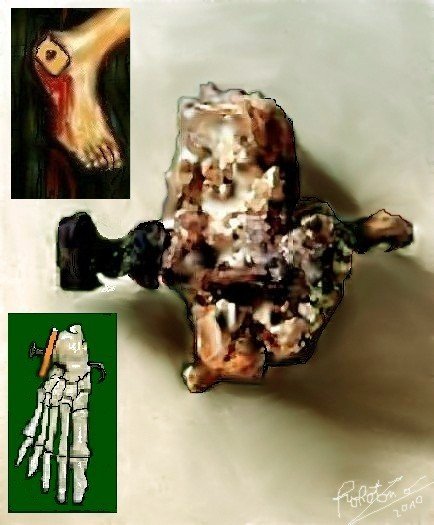A recent story making it’s rounds among those who fancy an interest in archaeology, history and “biblical” versions of both carries the headline “Archaeologists find crucifixion-style nail from the time of Jesus.”
My first thought was this would be cool. There are so few nails found that can be attributed to actual crucifixions, so this could provide some additional insight into the manufacture, style, etc. I was eager to read of a context that places the nail in the ground, perhaps with a talus or piece of wood still attached like that of the poor fellow’s heal found back in the 1960s (Haas 1970). His nail was bent, making it difficult to remove from the wood and foot. Its thought that the economic demands on Romans resulted in the removal of nails after the death of crucifixion victims for re-use.
But, as it happens, this nail wasn’t found in an original context. It was “discovered in an ornate box at a fort,” possibly from the period of the Crusades. The first crusades didn’t begin until almost 1200 years after the alleged time of Jesus. Still, the nail could be from his time. But there’s no mention of how the nail was dated. Only that it dated from the time of Jesus.

Betanzo (public domain)
One way, might be to test the patina on the surface of the nail. If the nail still retained original organic material or blood residue, this could possibly be dated. Similar dating has been done to rock art, but I’m not sure how the oxidation involved with iron might affect such an effort.
The Mirror says the nail is smooth, indicating that it had been handled by many people over a long period of time.
Darn. The patina idea wouldn’t work anyway. It was worn smooth.
The newspaper quotes Christopher Macklin of the Knights Templar of Britannia as calling last summer’s find “momentous.”
But there’s no mention of why it might be “momentous.” I’m still scratching my head and wondering why something “momentous” wouldn’t be mentioned by the “archaeologists” involved or why The Mirror wouldn’t be specific on this. It might be from the alleged time of Jesus. It might not.
He said evidence the nail had been handled a lot “indicates it was of great interest to many people” and that he believes the original Knights Templar thought it was a genuine artifact from Jesus’ crucifixion.
Rational clarification: evidence that the nail had been handled a lot indicates it was perceived to be of great interest.
We know that the Crusades were an attempt to “retake” Jerusalem and the “Holy Land.” We know that thousands upon thousands were killed in the name of superstition in an attempt to do so. We also have evidence that humans are willing to propagandize their political and religious positions, and what better way to do it than with a “holy relic” that rallies and inspires people? Why shouldn’t we believe that it is at least just as likely that the nail is every bit as fake as the shroud of Turin?
Moreover, of what significance is a single nail with no provenance or context outside of a fort that belonged to a 13th century military arm of a religion bent on controlling the minds of humanity?
I’d be more interested in the box it came in.
References and Further Reading
Haas N. (1970) Anthropological observations on the skeletal remains from Givat ha-Mivtar. Israel Exploration Journal, 20:38-59

I took ( swiped ) some nails and a consruction peg from a castle in germany that was under repair. I know this wasn’t correct but these were ther for the grabbing. These are obiously hand made. I would like to try to date them. They are in fabulous shape because they were not subjected to the elements. The history of the castle dates to 920AD but was destroyed and reconstructed a few times until 1512. I could send pictures if you would like. Joseph